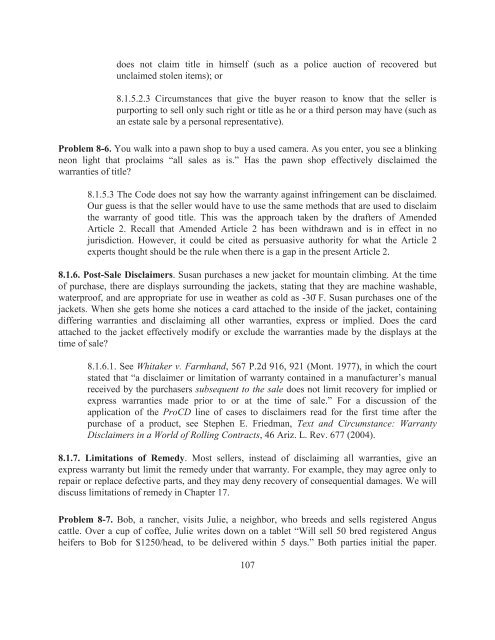Sales and Leases - A Problem-based Approach, 2016a
Sales and Leases - A Problem-based Approach, 2016a
Sales and Leases - A Problem-based Approach, 2016a
You also want an ePaper? Increase the reach of your titles
YUMPU automatically turns print PDFs into web optimized ePapers that Google loves.
does not claim title in himself (such as a police auction of recovered but<br />
unclaimed stolen items); or<br />
8.1.5.2.3 Circumstances that give the buyer reason to know that the seller is<br />
purporting to sell only such right or title as he or a third person may have (such as<br />
an estate sale by a personal representative).<br />
<strong>Problem</strong> 8-6. You walk into a pawn shop to buy a used camera. As you enter, you see a blinking<br />
neon light that proclaims “all sales as is.” Has the pawn shop effectively disclaimed the<br />
warranties of title?<br />
8.1.5.3 The Code does not say how the warranty against infringement can be disclaimed.<br />
Our guess is that the seller would have to use the same methods that are used to disclaim<br />
the warranty of good title. This was the approach taken by the drafters of Amended<br />
Article 2. Recall that Amended Article 2 has been withdrawn <strong>and</strong> is in effect in no<br />
jurisdiction. However, it could be cited as persuasive authority for what the Article 2<br />
experts thought should be the rule when there is a gap in the present Article 2.<br />
8.1.6. Post-Sale Disclaimers. Susan purchases a new jacket for mountain climbing. At the time<br />
of purchase, there are displays surrounding the jackets, stating that they are machine washable,<br />
waterproof, <strong>and</strong> are appropriate for use in weather as cold as -30̊ F. Susan purchases one of the<br />
jackets. When she gets home she notices a card attached to the inside of the jacket, containing<br />
differing warranties <strong>and</strong> disclaiming all other warranties, express or implied. Does the card<br />
attached to the jacket effectively modify or exclude the warranties made by the displays at the<br />
time of sale?<br />
8.1.6.1. See Whitaker v. Farmh<strong>and</strong>, 567 P.2d 916, 921 (Mont. 1977), in which the court<br />
stated that “a disclaimer or limitation of warranty contained in a manufacturer’s manual<br />
received by the purchasers subsequent to the sale does not limit recovery for implied or<br />
express warranties made prior to or at the time of sale.” For a discussion of the<br />
application of the ProCD line of cases to disclaimers read for the first time after the<br />
purchase of a product, see Stephen E. Friedman, Text <strong>and</strong> Circumstance: Warranty<br />
Disclaimers in a World of Rolling Contracts, 46 Ariz. L. Rev. 677 (2004).<br />
8.1.7. Limitations of Remedy. Most sellers, instead of disclaiming all warranties, give an<br />
express warranty but limit the remedy under that warranty. For example, they may agree only to<br />
repair or replace defective parts, <strong>and</strong> they may deny recovery of consequential damages. We will<br />
discuss limitations of remedy in Chapter 17.<br />
<strong>Problem</strong> 8-7. Bob, a rancher, visits Julie, a neighbor, who breeds <strong>and</strong> sells registered Angus<br />
cattle. Over a cup of coffee, Julie writes down on a tablet “Will sell 50 bred registered Angus<br />
heifers to Bob for $1250/head, to be delivered within 5 days.” Both parties initial the paper.<br />
107


















